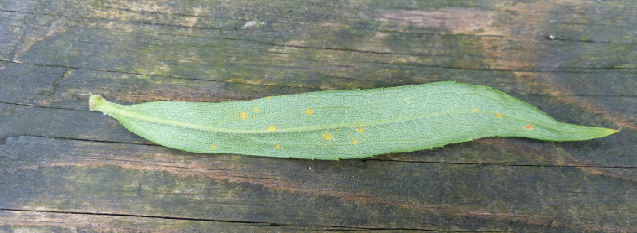Foraging for goldenrod may seem like one of the easier plants to identify and collect; and from one perspective it is. There are many varieties of goldenrods out there at this time of year and you’d think this is one of the easier plants to wildcraft. There is something to be wary of called rust.
Rusts such as Coleosporium, Puccinia, and Uromyces are a specialized group of fungal pathogens that tend to target some ferns and taller plants. These rusts are parasites that are dependent on a living host to complete their life cycle. However, some spores that are produced can survive on dead matter and reappear in the spring. Should one plant become infected the likelihood of nearby related plants getting infected is great. Large amounts of the spore inoculum travel long distances by wind so this parasite can travel as well.
Regardless of host, these fungal pathogens are easy to find when foraging. Rust can be identified by the minute, circular to elongate, golden or reddish brown to cinnamon brown pustules that usually forms on the lower leaf surfaces. These pustules eventually break through the leaf surface and release rust-colored, powdery spores.
If you grow goldenrod in your garden it is important to remove the infested plant as soon as rust pustules are found. At the end of the growing season be sure to remove all diseased goldenrods (or other diseased plants) from your garden because this fungus might survive the winter and cause problems for you the following year.
Wildcrafting Goldenrod
Foraging outdoors is no different than checking out the produce at a farmer’s market or grocery store aisle; you want to choose the best looking produce you can. This may become a nuisance with goldenrod as one plant can have numerous leaves and inspecting every leaf may seem time consuming. You do not want to consume goldenrod (or any edible plant for that matter) if it is infected with these fungal pathogens.
Yes, looking for this fungus will become a bother for you but it is important in order for your body to enjoy all the goldenrod has to offer.
Goldenrod Nutrients
The root and rhizome of goldenrod contain the carbohydrate, or fiber, known as inulin. Inulin is a prebiotic that helps stimulate the growth of healthy bacteria in the stomach and promotes colon health. The leaves contain numerous flavonoids, including kaempferol, quercitrin, rutin and quercetin. Other constituents include essential oil, mucilage, resin and saponin. The leaves are a good source of vitamin C.
It is used widely in medicinal herbal preparations and makes a great vinegar and oil!
So remember, please pick carefully and choose only healthy plants when foraging.





I can see why I might not want to bring it home due to it contaminating other plants in my yard, but will it actually make one sick if it is ingested?
Thanks
For most very healthy people probably not. If there is a weakened immune system or any other health ailment is can possibly pose a problem.
Great post. Do you know what specifically the dangers of golden rod rust would be?
It all depends on a number of factors such as a person’s immune system, overall health, health issues the person may have, etc.